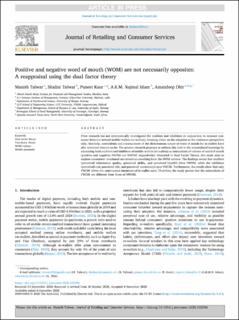| dc.contributor.author | Talwar, Manish | |
| dc.contributor.author | Talwar, Shalini | |
| dc.contributor.author | Kaur, Puneet | |
| dc.contributor.author | Islam, A.K.M. Najmul | |
| dc.contributor.author | Dhir, Amandeep | |
| dc.date.accessioned | 2021-03-18T11:50:42Z | |
| dc.date.available | 2021-03-18T11:50:42Z | |
| dc.date.created | 2021-01-18T12:14:52Z | |
| dc.date.issued | 2020 | |
| dc.identifier.citation | Talwar, M., Talwar, S., Kaur, P., Islam, A.K.M.N. & Dhir, A. (2020) Positive and negative word of mouth (WOM) are not necessarily opposites: A reappraisal using the dual factor theory In: Journal of Retailing and Consumer Services, 2020 . DOI: | en_US |
| dc.identifier.issn | 0969-6989 | |
| dc.identifier.uri | https://hdl.handle.net/11250/2734184 | |
| dc.description.abstract | Prior research has not systematically investigated the enablers and inhibitors in conjunction to measure consumer behavior toward mobile wallets (m-wallets), focusing either on the adoption or the resistance perspective only. Similarly, antecedents and consequences of the dichotomous nature of word of mouth for m-wallets have also remained obscure so far. The present research proposes to address this void in the accumulated learnings by examining both enablers and inhibitors of mobile wallets (m-wallets) as antecedents of valence of word of mouth (positive and negative; PWOM and NWOM, respectively). Grounded in Dual Factor Theory, this study aims to explore consumers’ continued use intentions resulting from the WOM valence. The findings reveal that enablers (perceived information quality, perceived ability, and perceived benefit) drive PWOM, while the inhibitors (perceived cost, perceived risk, and perceived uncertainty) spur NWOM. Furthermore, the results show that only PWOM drives the continuance intentions of m-wallet users. Therefore, the study proves that the antecedents of PWOM are different from those of NWOM. | en_US |
| dc.language.iso | eng | en_US |
| dc.publisher | Elsevier | en_US |
| dc.rights | Navngivelse 4.0 Internasjonal | * |
| dc.rights.uri | http://creativecommons.org/licenses/by/4.0/deed.no | * |
| dc.title | Positive and negative word of mouth (WOM) are not necessarily opposites: A reappraisal using the dual factor theory | en_US |
| dc.type | Journal article | en_US |
| dc.type | Peer reviewed | en_US |
| dc.description.version | publishedVersion | en_US |
| dc.rights.holder | © 2020 The Author(s) | en_US |
| dc.subject.nsi | VDP::Social science: 200::Economics: 210::Business: 213 | en_US |
| dc.source.pagenumber | 12 | en_US |
| dc.source.journal | Journal of Retailing and Consumer Services | en_US |
| dc.identifier.doi | 10.1016/j.jretconser.2020.102396 | |
| dc.identifier.cristin | 1873125 | |
| cristin.ispublished | true | |
| cristin.fulltext | original | |
| cristin.qualitycode | 1 | |

